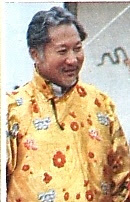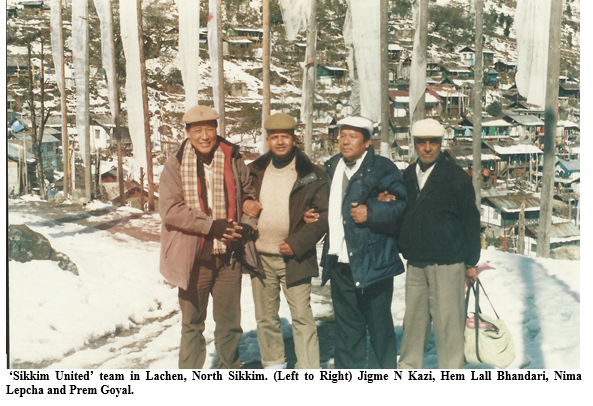GURUDONGMAR
LAKE CONTROVERSY
One of the major unresolved issues of
the former Kingdom of Sikkim, now a part of India, is the Gurudongmar Lake
controversy, which is also connected to the establishment of a Gurudwara, near a
historic Buddhist site at Chungthang, North Sikkim.
My book, The Lone Warrior: Exiled in My Homeland (published in 2014),
gives a background to the controversy.
Ever since the closure of the Indo-Tibet
border in North Sikkim in 1962 local residents of the region, particularly in
far-flung areas of Lachen and Lachung, have learnt to tolerate and get along
with the growing presence and clout of the Indian army in the region. The
peaceful co-existence between the two groups in the past so many decades has
always been mutually beneficial.
However, there are times when even the best
of relations are soured by mutual disrespect and unfriendly postures. The
deteriorating relations between army personnel and local residents bordering on
hatred and bitterness was evidenced in 1997-98 when a zealous chief of 20
Punjab Regiment made concerted efforts to convert the holy lake of Gurudongmar,
a sacred pilgrimage centre for Buddhists in Lachen, North Sikkim, into a Sikh
pilgrimage destination.
Matters reached a dizzying height of
confrontation when the Lachen Pipon, head of the Lachen Dzomsa – the
traditional assembly of the people – openly and quite defiantly, refuted
allegations made by the army that the Lachenpas supported the army’s bid to
construct a Gurudwara, a Sikh temple, at the lake’s vicinity.
“We wish to point out that at no point of
time that the local people of Lachen had requested the army to construct
anything at the premises of the holy lake, leave alone the Gurudwara shrine. Furthermore, let me as an elected
representative of the people of Lachen state clearly that it is neither in
their interest nor the aspiration of the local people to let anyone destroy the
sanctity of this lake,” said the Lachen Pipon, Anung Lachenpa, in a statement
published in the Observer in April 1998.
The Pipon also pointed out: “Construction of
a shrine belonging to another religion in the name of national integration at
our holy place of worship and pilgrimage does not reflect the hopes and
aspirations of the Lachenpas and other local people who visit the area.” He
also urged the “concerned authorities”, which included the State Government, to
“rectify the mistakes” and restore the “original look and sanctity of the
Gurudongmar Tso area.”
The first party to raise objections to
construction of the “highest Gurudwara on earth” (Gurudongmar is located at
17,200 ft. above sea level) was the Forests Department, which alleged that the
project was carried out without the mandatory clearance of the Ministry of
Environment and Forests. Besides the concrete construction of the Gurudwara
shrine four huts and a parking area were also built on the shores of the lake.
Apart from the ecological damage done to the area, which boasts of being a home
of some rare and endangered birds and animals such as Blacknecked Crane and
Kiang or Tibetan Wild Ass, the locals viewed the renaming of the Gurudongmar
Tso as Guru Nanak Jheel, an obvious bid to dilute and gradually erase the
unique and distinct Buddhist cultural heritage of the former Buddhist kingdom.
Tibetan Buddhist scriptures, quoting Guru
Rinpoche (Lord Padmasambhava, widely revered as the Second Buddha), point out
that Sikkim is one of the seven sacred and hidden lands for Buddhists in the
Himalaya. Except for Sikkim, all others are said to be in Tibet, where religious
freedom has been curtailed after the Chinese takeover in 1959. Locals believe
that when Guru Rinpoche visited Sikkim in the 8th century he blessed the lake
and thereafter it came to be known as “Gurudongmar Tso”, meaning Guru with red
face or red-face Guru (‘guru’ means master/teacher, ‘dong’ means face and ‘mar’
means red).
It is
possible that Guru Rinpoche manifested at the lake in the form of Gurudongmar
or Gurudrakpo (Gurdak in short form), which is one of the main aspects of the
tantric master who established Buddhism in Tibet and the Himalayan region in
the 8th century. Gurudramar – the red-face deity of Guru Rinpoche – is one of
the main protecting deities of several important monasteries in Sikkim,
including Lachen and Pemayangtse monasteries. It was the same deity who
appeared to the ancestors of Sikkim’s ruling Namgyal dynasty in a vision in the
13th century, instructing them to go southwards to ‘Bayul Demazong’, the
‘hidden valley of rice’, meaning Sikkim.
The conversion of the area around the sacred
rock in Chungthang in North Sikkim, enroute to Lachen and Lachung – also said
to have been blessed by Guru Rinpoche – into Guru Nanak Jheel, has also been
opposed by the locals. There exists a Gurudwara besides the sacred rock and the
entire area is fenced and renamed “Guru Nanak Jheel.” Many influential local
politicians, contractors and suppliers, who benefit financially and otherwise
from their dealings with the army, discourage locals from raising issues,
including religious matters, that would go against the army.

The Green Circle, one of the few credible
NGOs (non-governmental organization) in the State devoting to preserving the
fragile eco-system in the State, while reacting against the army’s “blatant
undermining of local culture and total disregard for a fragile and threatened
ecosystem” in the Gurudongmar controversy, in a statement published in the Observer
(Feb 1998) said: “As you are aware, the Gurudongmar lake is not only one of the
most beautiful lakes of Sikkim but also held sacred by the locals. The army,
because of its proximity and influence over these area cannot go about
misrepresenting facts. Such gradual and systematic distortion of history only
serves to sow the seeds of discontent and tension for the present and future
generations…Construction of a permanent structure at 17,200 feet with marble,
chandeliers and works is totally uncalled for and changing the surface of the
lake by moving earth to create parking space is most deplorable. In an
extremely sensitive ecosystem where even footprints stay for months, the army,
we hope will take more responsibility and care of their environs which would be
better served than find itself championing chauvinistic cultural imperialism.”

Though rather late, the Chamling Government
finally woke up and came to the people’s rescue and opposed army intervention
in the Gurudongmar controversy. A committee, whose members included State
Government officials, was set up by the government to investigate into the
controversy and restore the lake area to its original glory.
(Ref: The Lone Warrior: Exiled in My Homeland, Jigme N. Kazi, Hill Media Publications (published in 2014).





















